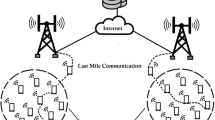Abstract
In this paper, we focus on fairness and stability of the congestion control mechanisms adopted in several versions of TCP by investigating their time–transient behaviors through an analytic approach. In addition to TCP Tahoe and TCP Reno, we also consider TCP Vegas which has been recently proposed for higher throughput, and enhanced TCP Vegas, which is proposed in this paper for fairness enhancements. We consider the homogeneous case, where two connections have the equivalent propagation delays, and the heterogeneous case, where each connection has different propagation delay. We show that TCP Tahoe and TCP Reno can achieve fairness among connections in the homogeneous case, but cannot in the heterogeneous case. We also show that TCP Vegas can provide almost fair service among connection, but there is some unfairness caused by the essential nature of TCP Vegas. Finally, we explain the effectiveness of our enhanced TCP Vegas in terms of fairness and throughput.
Similar content being viewed by others
References
J.S. Ahn, P.B. Danzig, Z. Liu and L. Yan, Evaluation with TCP Vegas: Emulation and experiment, ACM SIGCOMM Computer Communications Review 25 (August 1995) 185–195.
R. Ahuja, S. Keshav and H. Saran, Design, implementation, and performance of a native mode atm transport layer, in: Proc. of IEEE INFOCOM'6 (March 1996) pp. 206–214.
L.S. Brakmo, S.W. O'Malley and L.L. Peterson, TCP Vegas: New techniques for congestion detection and avoidance, in: Proc. of ACM SIGCOMM'94 (October 1994) pp. 24–35.
L.S. Brakmo and L.L. Peterson, TCP Vegas: End to end congestion avoidance on a global Internet, IEEE Journal on Selected Areas in Communications 13 (1995) 1465–1480.
D.-M. Chiu and R. Jain, Analysis of the increase and decrease algorithms for congestion avoidance in computer networks, Computer Networks and ISDN Systems 17 (1989) 1–14.
S. Floyd and V. Jacobson, Random early detection gateways for congestion avoidance, IEEE/ACM Transactions on Networking 1 (1993) 397–413.
J.C. Hoe, Improving the start-up behavior of a congestion control scheme of TCP, ACM SIGCOMM Computer Communications Review 26 (October 1996) 270–280.
M. Shreedhar and G. Varghese, Efficient fair queuing using deficit round robin, IEEE/ACM Transactions on Networking 4 (1996) 375–385.
W.R. Stevens, TCP/IP Illustrated, Vol. 1: The Protocols (Addison-Wesley, Reading, MA, 1994).
A.S. Tanenbaum, Computer Networks, 3rd ed. (Prentice-Hall, Upper Saddle River, NJ, 1996).
G.R. Wright and W.R. Stevens, TCP/IP Illustrated, Vol. 2: The Implementation (Addison-Wesley, Reading, MA, 1995).
XTP home page, http://www.ca.sandia.gov/xtp/xtp.html.
Author information
Authors and Affiliations
Rights and permissions
About this article
Cite this article
Hasegawa, G., Murata, M. & Miyahara, H. Fairness and stability of congestion control mechanisms of TCP. Telecommunication Systems 15, 167–184 (2000). https://doi.org/10.1023/A:1019186710820
Issue Date:
DOI: https://doi.org/10.1023/A:1019186710820




